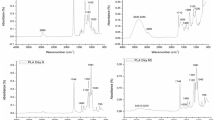Abstract
Previous research in our laboratory reported a convenient laboratory-scale composting test method to study the weight loss of polymer films in aerobic thermophilic (53°C) reactors maintained at a 60% moisture content. The laboratory-scale compost reactors contained the following synthetic compost mixture (percentage on dry-weight basis): tree leaves (45.0), shredded paper (16.5), food (6.7), meat (5.8), cow manure (17.5), sawdust (1.9), aluminum and steel shavings (2.4), glass beads (1.3), urea (1.9), and a compost seed (1.0) which is designated Mix-1 in this work. To simplify the laboratory-scale compost weight loss test method and better understand how compost mixture compositions and environmental parameters affect the rate of plastic degradation, a systematic variation of the synthetic mixture composition as well as the moisture content was carried out. Cellulose acetate (CA) with a degree of substitution (DS) value of 1.7 and cellophane films were chosen as test polymer substrates for this work. The extent of CA DS-1.7 and cellophane weight loss as a function of the exposure time remained unchanged when the metal and glass components of the mixture were excluded in Mix-2. Further study showed that large variations in the mixture composition such as the replacement of tree leaves, food, meat, and sawdust with steam-exploded wood and alfalfa (forming Mix-C) could be made with little or no change in the time dependence of CA DS-1.7 film weight loss. In contrast, substituting tree leaves, food, meat, cow manure, and sawdust with steam-exploded wood in combination with either Rabbit Choice (Mix-D) or starch and urea (Mix-E) resulted in a significant time increase (from 7 to 12 days) for the complete disappearance of CA DS-1.7 films. Interestingly, in this work no direct correlation was observed between the C/N ratio (which ranged from 13.9 to 61.4) and the CA DS-1.7 film weight loss. Decreasing moisture contents of the compost Mix-2 from 60 and 50 and 40% resulted in dramatic changes in polymer degradation such that CA DS-1.7 showed an increase in the time period for a complete disappearance of polymer films from 6 to 16 and 30 days, respectively.
Similar content being viewed by others
References
U.S Environmental Protection Agency (1989)The Solid Waste Dilemma: An Agenda for Action; Final Report of the Municipal Solid Waste Task Force, EPA/530-SW-89-019, U.S. Government Printing Office: Washington, DC.
J. Glenn and N. Goldstein (1992)BioCycle 33 48–52.
M. S. Finstein, F. C. Miller, and P. F. Strom (1986) in Rehm and G. Reed (Eds.), Biotechnology, Vol. 8, pp. 363–398.
J.-D. Gu, D. Eberiel, S. P. McCarthy, and R. A. Gross (1993)J. Environ. Polym. Degrad. 1 143–153.
R. A. Gross, J.-D. Gu, D. T., Eberiel, M. Nelson, and S. P. McCarthy (1993) in C. Ching, D. Kaplan, and E. Thomas (Eds.),Biodegradable Polymers and Packaging, Technomic, Lancaster, PA, pp. 257–279.
P. F. Strom (1985)Appl. Environ. Microbiol. 50 899–905.
D. S. Suler and M. S. Finstein (1977)Appl. Environ. Microbiol. 33 345–350.
D. F. Gilmore, S. Antoun, R. W. Lenz, S. Goodin, R. Austin, and R. C. Fuller (1992)J. Indust. Microbiol. 10 199–206.
M. S. Finstein, F. C. Miller, and P. F. Strom (1986)J. Water Pollut. Contr. Fed. 58 272–278.
J.-D. Gu, M. Gada, G. Kharas, D. Eberiel, S. P. McCarthy, and R. A. Gross (1992)Polym. Mater. Sci. Eng. 67 351–352.
J.-D. Gu, S. P. McCarthy, G. P. Smith, D. Eberiel, and R. A. Gross (1992)Polym. Mater. Sci. Eng. 67 230–231.
J.-D. Gu, D. Eberiel, S. P. McCarthy, and R. A. Gross (1993)J. Environ. Polym. Degrad. 1 281–291.
J.-D Gu, S. Coulter, D. Eberiel, S. P. McCarthy, and R. A. Gross (1993)J. Environ. Polym. Degrad. 1 293–299.
United States Department of Agriculture (1985)Forage Legumes for Energy-Efficient Animal Production, USDA, Washington, DC.
M. de Bertoldi, G. Vallini, and A. Pera (1983)Waste Manage. Res. 1 157–176.
F. C. Miller (1989)Microb. Ecol. 18 59–71.
Author information
Authors and Affiliations
Additional information
Guest Editor: Dr. Graham Swift, Rohm & Haas.
Rights and permissions
About this article
Cite this article
Gu, JD., Yang, S., Welton, R. et al. Effect of environmental parameters on the degradability of polymer films in laboratory-scale composting reactors. J Environ Polym Degr 2, 129–135 (1994). https://doi.org/10.1007/BF02074781
Issue Date:
DOI: https://doi.org/10.1007/BF02074781




